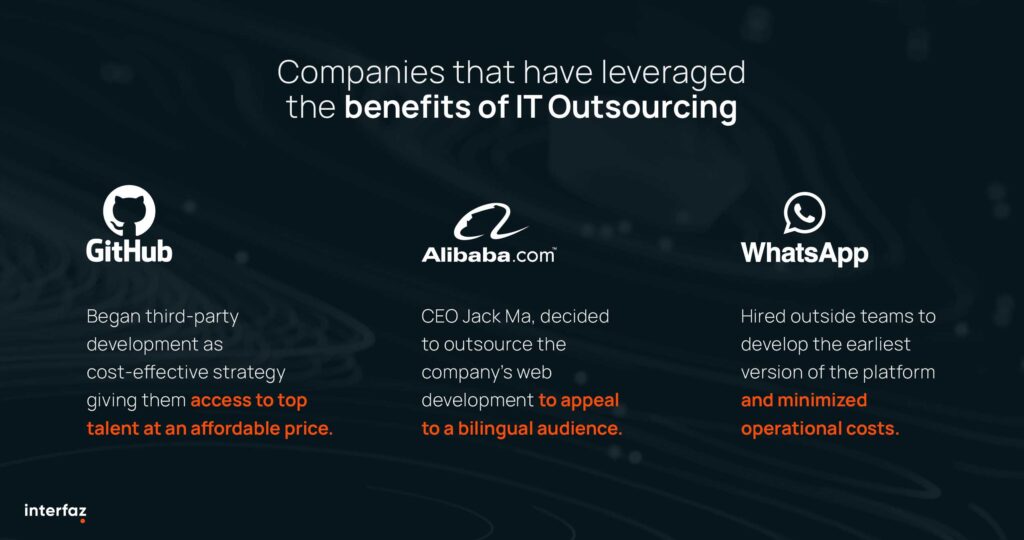The IT Outsourcing market last year (2023) generates USD 557.36 billion. An annual compound growth rate of 5.48% is projected, reaching USD 764.63 billion in the next five years (2028). Which recognized companies have relied on this strategy?

IT Outsourcing has become a key catalyst for business innovation. What was once defined as the use of external service providers to effectively deliver infrastructure, applications, and processes solutions; today is considered a strategy that adds significant value to companies to address innovation and build a solid and sustainable future.
Whenever a company leader is defining their projections and expectations, based on the needs of the company, key questions come to mind, such as: What strategies can I implement to reduce expenses in my department? How can I effectively address capacity problems in my company? What measures can accelerate transformation? Is outsourcing IT services a viable option?
As leaders, it is natural to face various questions about how to optimize resource management and address operational challenges. In this context, IT Outsourcing emerges as a key strategy to address these concerns effectively.
IT Outsourcing as an engine for Innovation
Outsourcing has transformed into more than just a cost-cutting technique with migrations and cloud service options. Today it is an engine of innovation that allows companies to access specialized knowledge, cutting-edge technologies, and advanced capabilities. It has also enabled companies to experiment with new technologies and approaches without having to make large investments in infrastructure and internal resources.
Companies like Alibaba, GitHub, and WhatsApp have leveraged the benefits of IT Outsourcing. In its early days, WhatsApp relied on companies from Eastern Europe to obtain technological talent and avoid high investments in its operation. Additionally, it hired offshore developers in Russia for software development. This allowed them to avoid losing focus on what was most critical at the time: customer service and operations.
Companies leveraging the benefits of IT Outsourcing

Another great example is VodafoneZiggo, a global telecommunications company, considered the engine of Dutch digitization. In November 2022, it chose Cognizant as a service partner to consolidate IT, cloud infrastructure, and mobile network operations. As part of the agreement, Cognizant will simplify the current local landscape through higher levels of automation designed to reduce total ownership costs and enable more efficient onboarding.
Lastly, we highlight the case of NN Life Japan from NN Group. A company with over 5,000 independent agents and more than 70 financial institutions (banks and brokerages), backed by sales offices in 28 cities across Japan. In December 2022, it relied on Infosys outsourcing services, which contributed to its end-to-end agile transformation to Azure Cloud and implemented agile processes. Today they have achieved 100% completion of a complex migration in an agile model, which had a large-scale impact on the entire organization.
Like these cases, there are hundreds more. Hence its projected growth of USD 764.63 billion by 2028. The economic outlook for 2024 indicates a clear trend towards technological innovation as the main driver of business growth and competitiveness. According to Gartner, it is estimated that over 60% of companies worldwide will have incorporated some level of digital transformation into their operational processes.
Given this scenario, leaders must consider that allocating a significant portion of their 2024 budget to IT outsourcing is not only prudent but essential to staying ahead in an increasingly digitized market.
Current challenges of IT Outsourcing
Just as we have outlined its growth projection and some cases where recognized companies have relied on this strategy to innovate on a scalable basis and improve operational efficiency, it is also crucial to understand the challenges and opportunities they face, ranging from data security to efficient supplier management.
In this context, we will explore the current challenges of IT outsourcing and provide recommendations for addressing them effectively.

Data security: With the growing proliferation of cyber threats, companies must ensure that IT service providers implement rigorous security measures to protect confidential information.
Supplier management: When working with multiple service providers, coordination and efficient management of operations can be challenging. Therefore, companies must establish clear supplier management processes and ensure smooth communication to avoid potential conflicts and delays.
Service quality: As companies outsource critical IT functions, the quality of service provided by suppliers becomes a key factor for success. It is essential to establish clear service level agreements (SLAs) and closely monitor the supplier’s performance to ensure that agreed quality standards are met.
System integration: Integrating external systems and processes with internal ones can be a complex technical challenge during the process. Companies must ensure that service providers have the necessary capacity and experience to effectively integrate systems and ensure seamless interoperability.
Regulatory compliance: Compliance with regulations related to data privacy and cybersecurity is an ongoing challenge. It is crucial that your provider complies with all relevant regulations and always maintains strict control.
It’s a strategic decision, take your time
If you are in a position to make the decision to choose a provider, take the time to analyze it. The figures show that its growth is evident, and more and more companies are turning to IT outsourcing as an innovation strategy. But before making any decision, our recommendation is to carefully analyze the specific needs of your company.
The first thing you should do is identify in which critical area it is most necessary: technical support, software development, or infrastructure management. This will facilitate a more strategic outsourcing. Also, it is essential to select a reliable partner, as this aspect will be crucial to the success of the process. Look for providers with solid experience, a consolidated reputation, and the ability to adapt to your company’s changing needs.
Lastly, once the process has begun, do it gradually. By doing it progressively, it is more viable to maximize long-term benefits. Start by outsourcing specific tasks and expand the scope as you see the needs grow.
To conclude
IT Outsourcing has become an engine of innovation for companies worldwide, providing access to specialized knowledge, cutting-edge technologies, and capabilities that would otherwise be difficult to obtain internally.
By outsourcing IT functions, companies can free up internal resources to focus on strategic and higher-value activities while benefiting from the expertise and efficiency of specialized service providers.
Think carefully. Do not see IT Outsourcing as an operational expense. Rather, see it as a strategic investment that you, as a company leader, should consider when planning the budget each year.
Give yourself the opportunity to build a solid and sustainable future, driven by innovation and technological excellence. Contact us to learn how together we can overcome current challenges in data security, process management, service quality, system integration, and regulatory compliance.
Resources:
Mordor Intelligence “IT Outsourcing Market 2023-2028”
Gartner: “Key Trends Shaping Logistics Outsourcing Practices in 2023”


